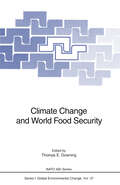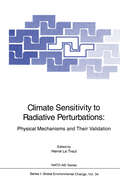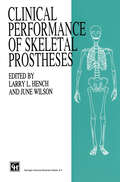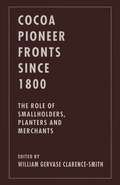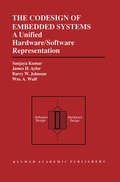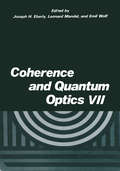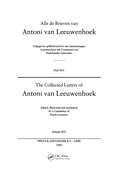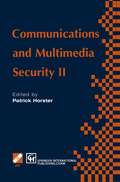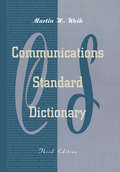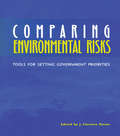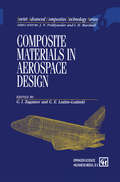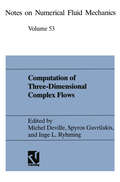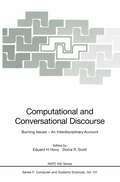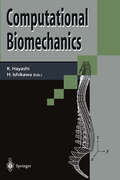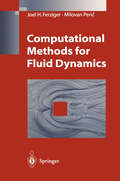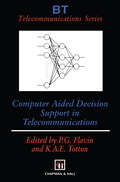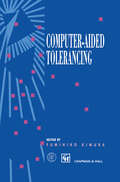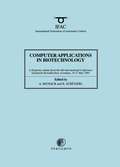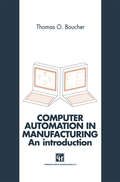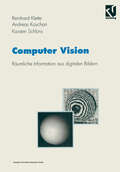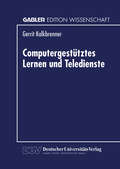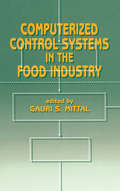- Table View
- List View
Climate Change and World Food Security (Nato ASI Subseries I: #37)
by Thomas E. DowningIn the last half decade since sustainable development became a serious objective, what have we achieved? Are livelihoods more secure? Are nations wealthier and more resilient? Is environmental quality being restored or maintained? These are essential questions of development. Their answers are many, varied between communities and regions, even between individuals. Two years ago, in the aftermath of the Earth Summit and ratification of the Framework Convention on Climate Change, but before the first Conference of Parties, I participated in a panel at the inaugural Oxford Environment Conference on Climate Change and World Food Security. The panel vigorously reviewed issues of resilient development and food security. This book is a product of the Oxford Environment Conference. It takes the essential questions of sustainability as a starting point to focus on present food security and its future prospects in the face of climate change. Why is this book important? First, I believe our goals to end hunger are under threat. We know what to do in many respects, but fail to generate the finances and political will to change the structures that thrive on poverty. Second, I believe concern about the environment has become dangerously separated from the fundamental issues of human deprivation. Third, I believe climate change is a serious threat and I am dismayed at the way nations dither over how to control greenhouse gas emissions and mechanisms to meet the challenge of adverse climate impacts.
Climate Sensitivity to Radiative Perturbations: Physical Mechanisms and Their Validation (Nato ASI Subseries I: #34)
by Herve LeTreutCurrent climate models diverge in their assessment of global warming that will result from the anthropogenic increase in trace gases. This is because they differ in their representation of the hydrological cycle (water vapour, clouds, snow and sea ice, soil moisture) and because a direct validation in terms of sensitivity is not possible. Indirect methods and approaches are therefore necessary to verify the models efficiently. The book provides an overview on different validation approaches. The use of satellite data is particularly stressed.
Clinical Performance of Skeletal Prostheses
by J. Wilson Larry HenchLarry L. Hench June Wilson OBJECTIVE Millions of people presently enjoy an improved quality of life due to prostheses which repair, augment or replace parts of their skeletal system: bones, joints, teeth, etc. However, all replacement parts have a finite probability of survival. The goal of this book is to compare the survivability data for various skeletal prosthesis systems. All data derive from previously published clinical studies. Where possible statistical comparisons are made and the reasons for failure are discussed. THE NEED FOR SKELETAL PROSTHESES We are an aging population with more than 100 million people in the U. S. and Europe over the age of 50 years. An unfortunate consequence of aging is a progressive deterioration of the quality of skeletal tissues. From the age of 30 years there is a decrease in bone mass for both men and women (Fig. 1. 1). However, for women it is much greater and between 40 and 60 years of age the rate of deterioration of long bones and vertebrae of women is especially severe due to hormonal changes. By the age of 70 most women will have lost from 35 to 60% of their bone mass. The loss of volume of cancellous or trabecular bone leads to a large decrease in mechanical compressive strength (Fig. 1. 2). The clinical consequence is an increasing incidence of vertebral collapse. Cortical bone decreases in tensile strength with age (Fig. 1.
Cocoa Pioneer Fronts since 1800: The Role of Smallholders, Planters and Merchants
by William Gervase Clarence-SmithThe livelihood of Third World farmers conflicts with saving the remaining tropical forests. The advantages of growing cocoa in cleared primary forest drive from the fertility of virgin soils and low concentrations of weeds, pests and diseases. The consequent emergence of new 'pioneer fronts' has also been affected by cheap labour, relative commodity prices, pests and diseases, credit resources, entrepreneurship, information, physical infrastructures, and government policies. The dynamism of smallholdings and competitive private marketing over estates and marketing boards is demonstrated.
The Codesign of Embedded Systems: A Unified Hardware/Software Representation
by Sanjaya Kumar James H. Aylor Barry W. Johnson Wm.A. WulfCurrent practice dictates the separation of the hardware and software development paths early in the design cycle. These paths remain independent with very little interaction occurring between them until system integration. In particular, hardware is often specified without fully appreciating the computational requirements of the software. Also, software development does not influence hardware development and does not track changes made during the hardware design phase. Thus, the ability to explore hardware/software tradeoffs is restricted, such as the movement of functionality from the software domain to the hardware domain (and vice-versa) or the modification of the hardware/software interface. As a result, problems that are encountered during system integration may require modification of the software and/or hardware, resulting in potentially significant cost increases and schedule overruns. To address the problems described above, a cooperative design approach, one that utilizes a unified view of hardware and software, is described. This approach is called hardware/software codesign. The Codesign of Embedded Systems develops several fundamental hardware/software codesign concepts and a methodology that supports them. A unified representation, referred to as a decomposition graph, is presented which can be used to describe hardware or software using either functional abstractions or data abstractions. Using a unified representation based on functional abstractions, an abstract hardware/software model has been implemented in a common simulation environment called ADEPT (Advanced Design Environment Prototyping Tool). This model permits early hardware/software evaluation and tradeoff exploration. Techniques have been developed which support the identification of software bottlenecks and the evaluation of design alternatives with respect to multiple metrics. The application of the model is demonstrated on several examples. A unified representation based on data abstractions is also explored. This work leads to investigations regarding the application of object-oriented techniques to hardware design. The Codesign of Embedded Systems: A Unified Hardware/Software Representation describes a novel approach to a topic of immense importance to CAD researchers and designers alike.
Coherence and Quantum Optics VII: Proceedings of the Seventh Rochester Conference on Coherence and Quantum Optics, held at the University of Rochester, June 7–10, 1995
by J. H. Eberly L. Mandel E. WolfThe Seventh Rochester Conference on Coherence and Quantum Optics was held on the campus of the University of Rochester during the four-day period June 7 - 10, 1996. More than 280 scientists from 33 countries participated. This book contains the Proceedings of the meeting. This Conference differed from the previous six in the series in having only a limited number of oral presentations, in order to avoid too many parallel sessions. Another new feature was the introduction of tutorial lectures. Most contributed papers were presented in poster sessions. The Conference was sponsored by the American Physical Society, by the Optical Society of America, by the International Union of Pure and Applied Physics and by the University of Rochester. We wish to express our appreciation to these organizations for their support and we especially extend our thanks to the International Union of Pure and Applied Physics for providing financial assistance to a number of speakers from Third World countries, to enable them to take part in the meeting.
The Collected Letters of Antoni Van Leeuwenhoek - Volume 14
by A. Committee A Committee of Dutch ScientistsThis volume (the 14th of a series of 19) contains 21 letters written between August 1701 and March 1704. At least half of these letters were addressed to Fellows of the Royal Society in London. Every volume in the series contains the texts in the original Dutch and an English translation. The great range of subjects studied by Van Leeuwenhoek is reflected in these letters: instruments to measure water; pulmonary diseases; experiments relating to the solution of gold and silver; salt crystals and grains of sand; botanical work, such as duckweed and germination of orange pips; descriptions on protozoa; blood; spermatozoa; and health and hygiene, for example and harmfulness of tea and coffee and the benefits of cleaning teeth.;Volumes One to 13 are available at a reduced price from Swets and Zeitlinger.
The Collected Letters of Antoni Van Leeuwenhoek - Volume 14
by L. C. PalmThis volume (the 14th of a series of 19) contains 21 letters written between August 1701 and March 1704. At least half of these letters were addressed to Fellows of the Royal Society in London. Every volume in the series contains the texts in the original Dutch and an English translation. The great range of subjects studied by Van Leeuwenhoek is reflected in these letters: instruments to measure water; pulmonary diseases; experiments relating to the solution of gold and silver; salt crystals and grains of sand; botanical work, such as duckweed and germination of orange pips; descriptions on protozoa; blood; spermatozoa; and health and hygiene, for example and harmfulness of tea and coffee and the benefits of cleaning teeth.;Volumes One to 13 are available at a reduced price from Swets and Zeitlinger.
Communications and Multimedia Security II (IFIP Advances in Information and Communication Technology)
by Patrick HorsterIn multimedia and communication environments all documents must be protected against attacks. The movie Forrest Gump showed how multimedia documents can be manipulated. The required security can be achieved by a number of different security measures. This book provides an overview of the current research in Multimedia and Communication Security. A broad variety of subjects are addressed including: network security; attacks; cryptographic techniques; healthcare and telemedicine; security infrastructures; payment systems; access control; models and policies; auditing and firewalls. This volume contains the selected proceedings of the joint conference on Communications and Multimedia Security; organized by the International Federation for Information processing and supported by the Austrian Computer Society, Gesellschaft fuer Informatik e.V. and TeleTrust Deutschland e.V. The conference took place in Essen, Germany, in September 1996
Communications Standard Dictionary
by Martin WeikNow in its Third Edition, the Communications Standard Dictionary maintains its position as the most comprehensive dictionary covering communications technologies available. A one-of-a-kind reference, this dictionary remains unmatched in the breadth and scope of its coverage nd its pprimary reference for communications, computer, data processing, and control systems professionals.
Comparing Environmental Risks: Tools for Setting Government Priorities
by J. Clarence DaviesThe budgetary squeeze of the 1990s has made it obvious that the government cannot address every possible environmental problem. Comparative risk assessment (CRA) is increasingly advanced as the means for setting realistic priorities. RFF's Center for Risk Management commissioned background papers from leading experts on CRA for a meeting with federal regulatory officials. Comparing Environmental Risks presents the revised papers of this workshop. Representing the state of the art on programmatic CRA, its methodological analyses and practical recommendations will be invaluable to government officials, independent analysts, and anyone studying environmental policy.
Comparing Environmental Risks: Tools for Setting Government Priorities
by J. Clarence DaviesThe budgetary squeeze of the 1990s has made it obvious that the government cannot address every possible environmental problem. Comparative risk assessment (CRA) is increasingly advanced as the means for setting realistic priorities. RFF's Center for Risk Management commissioned background papers from leading experts on CRA for a meeting with federal regulatory officials. Comparing Environmental Risks presents the revised papers of this workshop. Representing the state of the art on programmatic CRA, its methodological analyses and practical recommendations will be invaluable to government officials, independent analysts, and anyone studying environmental policy.
Composite Materials in Aerospace Design (Soviet Advanced Composites Technology Series #6)
by G. I. Zagainov G. E. Lozino-LozinskiComposite Materials in Aerospace Design is one of six titles in a coherent and definitive series dedicated to advanced composite materials research, development and usage in the former Soviet Union. Much of the information presented has been classified until recently. Thus each volume provides a unique insight into hitherto unknown research and development data. This volume deals with the design philosophy and methodology used to produce primary and secondary load bearing composite structures with high life expectancies. The underlying theme is of extensive advanced composites research and development programs in aircraft and spacecraft applications, including the space orbital ship `BURAN'. The applicability of much of this work to other market sectors, such as automotive, shipbuilding and sporting goods is also examined in some detail. The text starts by describing typical structures for which composites may be used in this area and some of the basic requirements from the materials being used. Design of components with composite materials is then discussed, with specific reference to case studies. This is followed by discussion and results from evaluation of finished structures and components, methods of joining with conventional materials and finally, non-destructive testing methods and forecasting of the performance of the composite materials and the structures which they form. Composite Materials in Aerospace Design will be of interest to anyone researching or developing in composite materials science and technology, as well as design and aerospace engineers, both in industry and universities.
Computation of Three-Dimensional Complex Flows: Proceedings of the IMACS-COST Conference on Computational Fluid Dynamics Lausanne, September 13–15, 1995 (Notes on Numerical Fluid Mechanics #49)
by Michel Deville Spyros Gavrilakis Inge L. RyhmingDer Sammelband enthält Beiträge einer Tagung über die Simulation von dreidimensionalen Flüssigkeiten. Sie geben einen Überblick über den Stand des Wissens auf dem Gebiet der numerischen Simulation der Turbulenz, angewandt auf eine weite Spanne von Problemen wie Aerodynamik, Nicht-Newtonsche Flüssigkeiten, Konvektion.This volume contains the material presented at the IMACS-COST Conference on CFD, Three-Dimensional Complex Flows, held in Lausanne (Switzerland), September 13 - 15, 1995. It gives an overview of the current state of numerical simulation and turbulence modelling applied to a wide range of fluid flow problems such as an example aerodynamics, non-Newtonian flows, transition, thermal convection.
Computational and Conversational Discourse: Burning Issues — An Interdisciplinary Account (NATO ASI Subseries F: #151)
by Eduard H. Hovy Donia R. ScottThis fascinating volume is based on a multidisciplinary workshop for linguists, sociologists and computational linguists. The authors discuss their favorite burning issues in discourse and display their own methodologies and styles of argumentation.
Computational Methods for Fluid Dynamics
by Joel H. Ferziger Milovan PericA detailed description of the methods most often used in practice. The authors are experts in their fields and cover such advanced techniques as direct and large-eddy simulation of turbulence, multigrid methods, parallel computing, moving grids, structured, block-structured and unstructured boundary-fitted grids, and free surface flows. The book shows common roots and basic principles for many apparently different methods, while also containing a great deal of practical advice for code developers and users. All the computer codes can be accessed from the Springer server on the internet. Designed to be equally useful for beginners and experts.
Computer Aided Decision Support in Telecommunications (BT Telecommunications Series #8)
by Phil G. Flavin Ken A. E. TottonIn bringing together this book, the editors have kept two goals in mind. Firstly, the goal of educating the reader by giving an insight into the wealth of computing and mathematical techniques now being used to build decision support systems. Secondly, of aiming to stimulate the imagination by including an eclectic mix of contributions from a wide range of business areas to demonstrate that there is no field in which modern decision support techniques cannot usefully be applied. The quintessence of decision support systems is that they are designed to assist people in establishing the best course of action in a given situation but not to automate or tell them prescriptively how to achieve a goal.
Computer-aided Tolerancing: Proceedings of the 4th CIRP Design Seminar The University of Tokyo, Tokyo, Japan, April 5–6, 1995
by Fumihiko KimuraTheory and practice of tolerances are very important for designing and manufacturing engineering artifacts on a rational basis. Tolerance specifies a degree of "discrepancy" between an idealized object and its physical realization. Such discrepancy inevitably comes into our product realization processes because of practical cost consideration or our inability to fully control manufacturing processes. Major product and production characteristics which are affected by tolerances are product quality and cost. For achieving high precision machines tight tolerance specification is necessary, but this will normally increase product cost. In order to optimally compromise the conflicting requirements of quality and cost, it is essential to take into account of the total product life cycle throughout product planning, design, manufacturing, maintenance and recycling. For example, in order to construct durable products under severe working conditions, low sensitivity of product functionality with respect to tolerances is required. In future, re-use of components or parts will become important, and tolerance synthesis with respect to this aspect will be an interesting future research topics.
Computer Applications in Biotechnology (IFAC Postprint Volume)
by A. Munack K. SchönertThe 6th Computer Applications in Biotechnology (CAB6) conference was a continuation of 2 series of events: the IFAC symposia on Modelling and Control of Biotechnical Processes and the International Conferences on Computer Applications in Fermentation Technology. This conference provided the opportunity for both sides, leading researchers and industrial practitioners, in this interdisciplinary field to exchange new ideas and technology; concepts and solutions. This postprint volume contains all those papers which were presented at the conference.
Computer Automation in Manufacturing: An introduction
by Thomas O. Bouchero Computer Automation in Manufacturing provide instruction in computer architecture, interfacing to mechanical systems, and software development for continuous control and discrete event systems. This is accomplished by presenting theoretical material and hands-on laboratory experiments.
Computer Vision: Räumliche Information aus digitalen Bildern (Studium Technik)
by Reinhard Klette Andreas Koschan Karsten SchlünsDieses Lehrbuch behandelt die Grundlagen, Algorithmen und Anwendungen eines Teilbereichs der digitalen Bildverarbeitung: die Szenenanalyse bzw. die 3D-Bildanalyse. Methoden der Bildbearbeitung und der Musteranalyse stellen Werkzeuge dar, um aus den Bildinformationen von dreidimensionalen Objekten Ausgangsdaten für die Bildinterpretation zu erzeugen.
Computergestütztes Lernen und Teledienste
by Gerrit KalkbrennerFür computergestütztes Lernen ergeben sich aus der Weiterentwicklung der multimedialen Fähigkeiten von Computern und ihrer breitbandigen Vernetzung neue Freiräume der Gestaltung, insbesondere für die Veranschaulichung von dynamischen Vorgängen.
Computerized Control Systems in the Food Industry
by MittalCovers the fundamentals and the latest advances in computerized automation and process control, control algorithms, and specific applications essential food manufacturing processes and unit operations. This text highlights the use of efficient process control to convert from batch to continuous operation and enhance plant sanitation. It compares both established and innovative control schemes.
Computerized Control Systems in the Food Industry
by MittalCovers the fundamentals and the latest advances in computerized automation and process control, control algorithms, and specific applications essential food manufacturing processes and unit operations. This text highlights the use of efficient process control to convert from batch to continuous operation and enhance plant sanitation. It compares both established and innovative control schemes.
